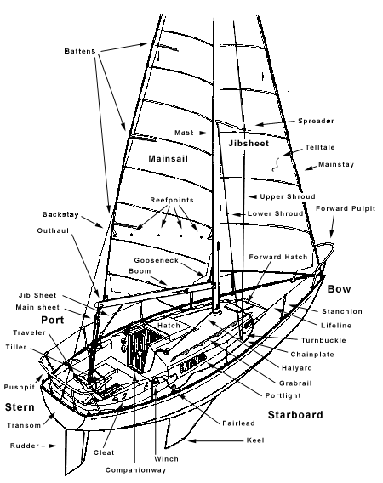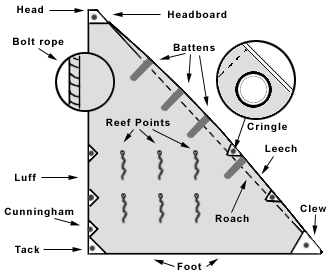Besides the common port and starboard (left and right when facing forward), you should know some colorful, ancient, and very useful terminology.

1 - Hull
The hull is the body of the boat. Its front end is the bow; the back is the stern or transom. The top covering is the deck, and the cockpit is the area in which the Skipper and crew sit. The hull's top edges are gunwales (pronounced "gunnels"), and the fin extending straight down on the bottom of the hull is the centerboard or daggerboard. The centerboard prevents the boat from drifting sideways and increases stability. A centerboard is hinged inside a centerboard trunk and pulled up by a line (all ropes on a boat are called lines) called a centerboard pennant. A daggerboard does not pivot up and down on a pin as does the centerboard, but slides vertically into the daggerboard trunk. Bigger boats have stationary keels (most of them with heavy ballasts). At the stern is the rudder, held onto the hull by pintles (pins) and gudgeons. The rudder, which controls the direction of the boat, has a handle called the tiller. Bigger boats have wheels attached to the tiller by some means (lines, chains or hydrolic). In strong winds, when it is necessary to sit on the gunwales and hike out, one needs an extension for the tiller called a hiking stick. Small unballasted sailboats are referred to as dinghies to distinguish them from keelboats that have a ballasted keel.
2 - Spars and Rigging
The long vertical spar holding the sail is the mast, and the horizontal spar holding the sail is the boom. Rigging refers to the lines and wires securing the spars and sails. The standing rigging, usually wire, is found fixed in place. The shrouds keep the mast from falling sideways, and the stays support it fore and aft (front and back). Running rigging is not fixed and is usually line rather then wire. Sheets are the lines that let the sail in or out, i.e. control the angle of the sail in relation to the wind. They are usually run through a block (pulley) or a series of blocks. The mainsheet may have a block that slides back and forth on a traveler. The traveler permits the mainsheet block to move to the side of the boat so that the block is directly below the boom. The halyards hoist the sails. The tension in the leading edges of the sail may be controlled by a downhaul or cunningham. A downhaul line pulls on the boom whereas a cunningham line runs through a hole in the sail and pulls down on the sail. The boom vang prevents the boom from rising when off the wind, keeping the sail flat. The painter is a line attached to the bow used to tie the boat to the dock.
3 - Sails :
Sails are flexible airfoils that use wind pressure to provide thrust. (Most sails are made of a synthetic material, Dacron(tm), that does not mildew or rot when wet.)
Names of Sails
In square-rigged ships, sails are named for the position they occupy. Ahead of the foremast on a typical ship, four small triangular sails are hung from stays between the bowsprit and the foremast. These sails are known, from fore to aft, as flying jib, outer jib, inner jib, and jib, and are fore-and-aft sails. Hung from yards on each of the masts, foremast, mainmast, and mizzenmast are six rectangular or square sails of different sizes. The lowest sails on each mast are called the foresail, mainsail, and mizzensail, or crossjack. The two sails above the lowest on each mast are known as the upper topsail and lower topsail and are identified according to the mast from which they hang, as mizzen-upper topsail. Above the upper topsails are the topgallant sails and above these, the royals and the skysails. The lowest sail on each mast, and sometimes the topsail, may also be called a course. Between the foremast and the mainmast, triangular sails are mounted on stays that slant downward from the mainmast to the foremast. These sails are known as the main-topmast staysail, the main-topgallant staysail, and the main-royal staysail. Sometimes, staysails are similarly attached to stays between the main and mizzenmasts. A small four-sided fore-and-aft sail mounted on the mizzenmast with a boom at the foot and another spar called a gaff at the head of the sail is known as the spanker. The naming of sails on fore-and-aft-rigged ships depends on the masts and the arrangement of the stays. A typical two-masted schooner carries two sails-a staysail and a jib-ahead of the foremast. The foremast has a triangular or four-sided foresail, and in the latter case may also have a gaff topsail mounted between the gaff of the foresail and the mast. On the mainmast is the triangular or four-sided mainsail; there may also be a main staysail between the foremast and mainmast. Schooners and other fore-and-aft-rigged vessels having quadrangular foresails and mainsails are said to be gaffheaded, and those having triangular sails in these positions are said to be Marconi-rigged or Bermuda-rigged. Sometimes, schooners also carry a square sail on a yard on the foremast and above it another quadrangular sail called a raffe, which is secured to the yard at the foot. The sail plan of a ketch consists, forward to aft, of staysail, jib, mainsail, and mizzensail, and that of a yawl consists of staysail, jib, mainsail, and jigger. Cutters and sloops carry staysail, jib, and mainsail only. Certain of the above types of boats sometimes substitute a Genoese jib for the jib and staysail. This sail is a large jib with a long foot that overlaps the mainmast or foremast. When the boat is running before the wind, a spinnaker may be set in place of jib and staysail. This is a triangular sail cut with such great fullness that it is sometimes called a balloon jib, or ballooner, with its peak hoisted to the top of the foremast and its foot extended over the side of the vessel by means of a demountable spinnaker pole that is secured to the side of the foremast or mainmast.

Each part of the triangular sail has a name. The leading edge (into the wind) is the luff, the trailing, curved edge is the leech, and the bottom is the foot. The leech is cut in a full curve in order to increase the sail area. (A sailboat's potential power is proportional to its sail area.) This extended area above the triangle is the roach. It is supported by a series of thin, wooden or fiberglass battens fitting into the batten pockets. The lower forward corner of the sail is the tack, the aft corner is the clew, and the top is known as the head. Parallel to the boom may be a row of short pieces of line called reef points, used to tie around the boom to reduce the sail area in heavy weather. Small boats may only have a single sail, a mainsail, in which case they are referred to as cat-rigged. A sloop-rigged boat has a mainsail and a smaller jib sail that has its luff fastened to the forestay. The sheet that controls the mainsail is the mainsheet. The jib sail is controlled by the jib sheets one on the port one on the starboard side. Only one jib sheet should be tight at any time. A spinnaker is a large, light, often colorful sail for reaching and running downwind. The tack is held out to windward with one end of a spinnaker pole and fastened to the tack is a guy . The spinnaker's clew is attached to the spinnaker sheet. The guy and sheet pass through blocks into the cockpit.
| Contents | 1 | 2 | 3 | 4 | 5 | 6 | 7 | 8 | 9 | 10 | 11 | 12 | 13 | 14 | 15 | 16 | 17 | 18 | 19 |
[Previous Chapter] [Next Chapter]